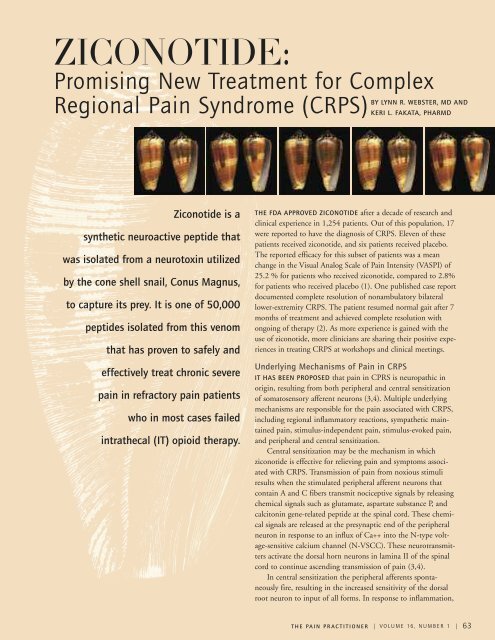printer-friendly version (PDF) - Reflex Sympathetic Dystrophy ...
printer-friendly version (PDF) - Reflex Sympathetic Dystrophy ...
printer-friendly version (PDF) - Reflex Sympathetic Dystrophy ...
Create successful ePaper yourself
Turn your PDF publications into a flip-book with our unique Google optimized e-Paper software.
ZICONOTIDE:<br />
Promising New Treatment for Complex<br />
Regional Pain Syndrome (CRPS)<br />
BY LYNN R. WEBSTER, MD AND<br />
KERI L. FAKATA, PHARMD<br />
Ziconotide is a<br />
synthetic neuroactive peptide that<br />
was isolated from a neurotoxin utilized<br />
by the cone shell snail, Conus Magnus,<br />
to capture its prey. It is one of 50,000<br />
peptides isolated from this venom<br />
that has proven to safely and<br />
effectively treat chronic severe<br />
pain in refractory pain patients<br />
who in most cases failed<br />
intrathecal (IT) opioid therapy.<br />
THE FDA APPROVED ZICONOTIDE after a decade of research and<br />
clinical experience in 1,254 patients. Out of this population, 17<br />
were reported to have the diagnosis of CRPS. Eleven of these<br />
patients received ziconotide, and six patients received placebo.<br />
The reported efficacy for this subset of patients was a mean<br />
change in the Visual Analog Scale of Pain Intensity (VASPI) of<br />
25.2 % for patients who received ziconotide, compared to 2.8%<br />
for patients who received placebo (1). One published case report<br />
documented complete resolution of nonambulatory bilateral<br />
lower-extremity CRPS. The patient resumed normal gait after 7<br />
months of treatment and achieved complete resolution with<br />
ongoing of therapy (2). As more experience is gained with the<br />
use of ziconotide, more clinicians are sharing their positive experiences<br />
in treating CRPS at workshops and clinical meetings.<br />
Underlying Mechanisms of Pain in CRPS<br />
IT HAS BEEN PROPOSED that pain in CPRS is neuropathic in<br />
origin, resulting from both peripheral and central sensitization<br />
of somatosensory afferent neurons (3,4). Multiple underlying<br />
mechanisms are responsible for the pain associated with CRPS,<br />
including regional inflammatory reactions, sympathetic maintained<br />
pain, stimulus-independent pain, stimulus-evoked pain,<br />
and peripheral and central sensitization.<br />
Central sensitization may be the mechanism in which<br />
ziconotide is effective for relieving pain and symptoms associated<br />
with CRPS. Transmission of pain from noxious stimuli<br />
results when the stimulated peripheral afferent neurons that<br />
contain A and C fibers transmit nociceptive signals by releasing<br />
chemical signals such as glutamate, aspartate substance P, and<br />
calcitonin gene-related peptide at the spinal cord. These chemical<br />
signals are released at the presynaptic end of the peripheral<br />
neuron in response to an influx of Ca++ into the N-type voltage-sensitive<br />
calcium channel (N-VSCC). These neurotransmitters<br />
activate the dorsal horn neurons in lamina II of the spinal<br />
cord to continue ascending transmission of pain (3,4).<br />
In central sensitization the peripheral afferents spontaneously<br />
fire, resulting in the increased sensitivity of the dorsal<br />
root neuron to input of all forms. In response to inflammation,<br />
T H E PA I N P R A C T I T I O N E R | V O L U M E 16 , N U M B E R 1 | 63
















